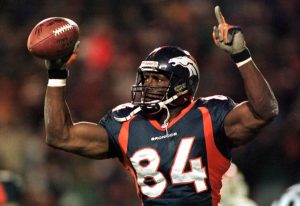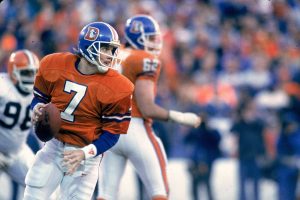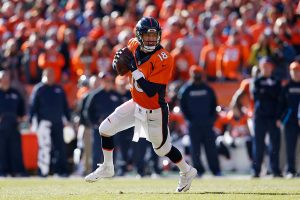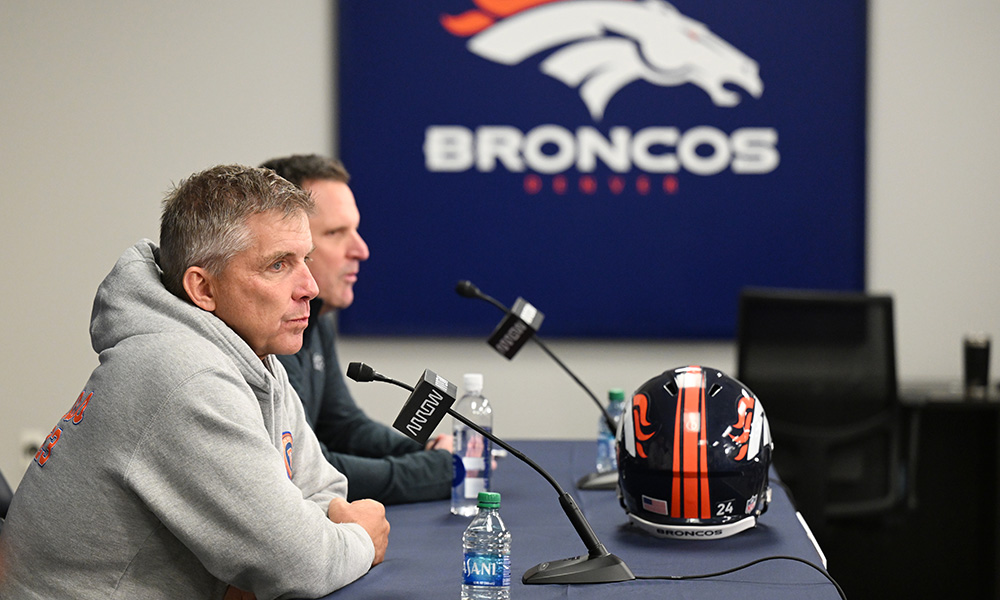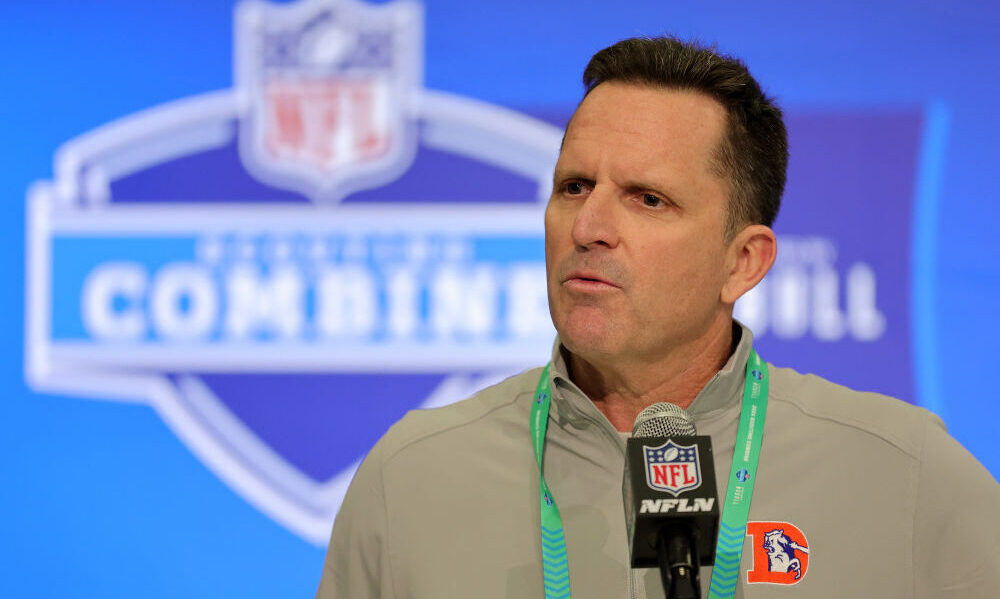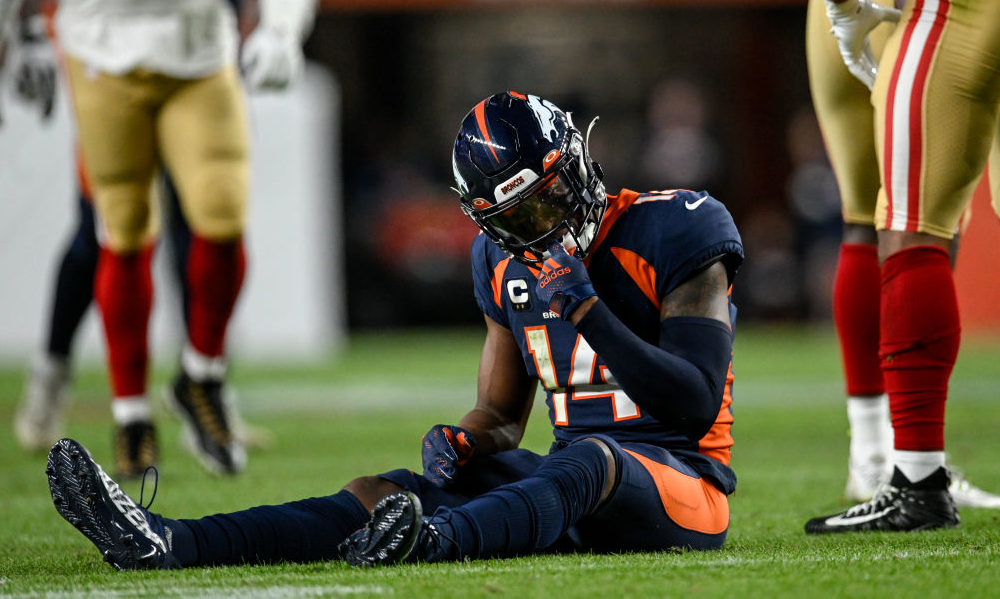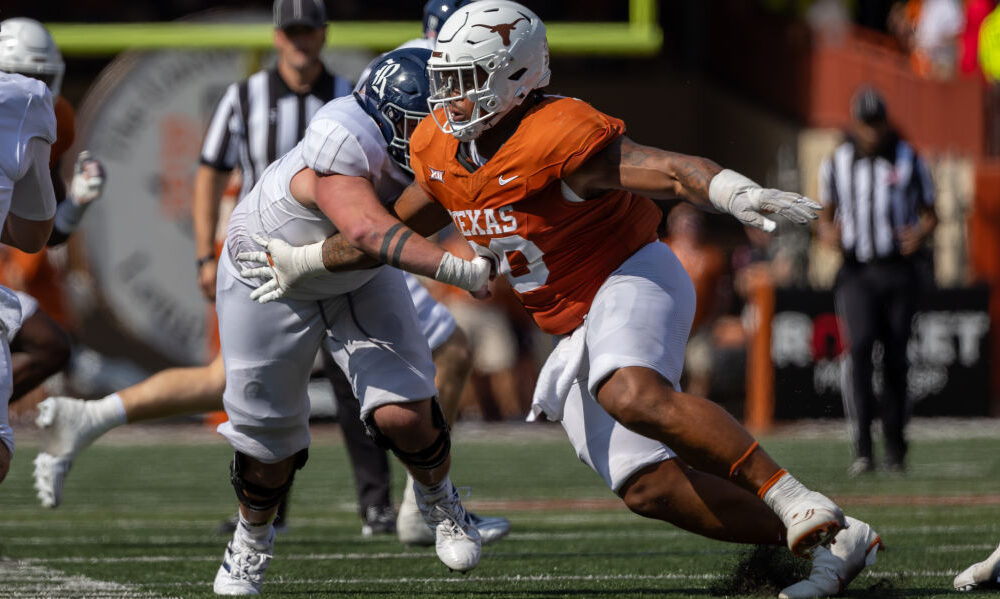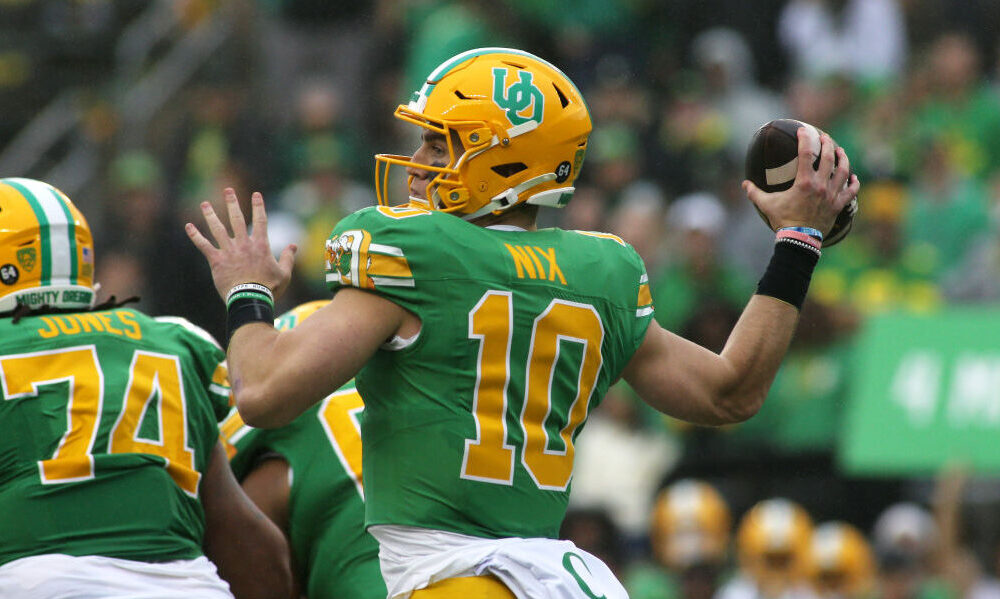Sixty Since 60: The greatest Broncos of all-time, Nos. 1-5
Jul 10, 2019, 10:11 PM
On September 9, 1960, the Broncos played in the upstart American Football League’s first-ever game, beating the Patriots 13-10 in Boston. On September 9, 2019, Denver will kick off the 60th season in franchise history when they travel to Oakland to take another of the AFL’s original teams, the Raiders.
Sixty seasons. Starting in 1960. It’s all too symmetrical and perfect not to celebrate.
From that first season through today, thousands of players have donned the orange and blue (and even the brown and yellow). Plenty came and went, having forgettable careers in the Mile High City. But a select few stood out. And a handful of Broncos became legends, in this town and beyond.
Who falls into that category? In the coming weeks, 1043TheFan.com will count down the 60 greatest players in Broncos history.
It continues today, with Nos. 1-5.
***
5. Shannon Sharpe | TE | 1990-99 / 2002-03
The player who arrived in Denver hardly resembled the one who retired there 14 seasons later. Initially, he was a wide receiver from tiny Savannah State, a seventh-round pick wearing No. 81 who was best known for being “Sterling’s little brother.” But eventually, he’d become one of the best tight ends in NFL history, a draft steal and the more-accomplished Sharpe.
After catching just seven passes as a rookie and 22 more in year two, Shannon Sharpe became a bona fide star in his third season as a pro. In 1992, the Broncos figured out how to use the converted wideout to be a match-up nightmare, as opposing linebackers couldn’t cover him in the middle of the field, and his numbers exploded. That year, Sharpe caught 53 passes for 640 yards and two touchdowns, earning his first Pro Bowl invite.
That was the first of seven-consecutive seasons in Denver where he’d make the trip to Honolulu at the end of the year. During that time, Sharpe became the most-prolific pass-catching tight end the NFL had seen up until that point. On three different occasions, he surpassed the 1,000-yard mark, with a career-high 1,107 coming in 1997. In ’96 and ’98, he caught 10 touchdown passes, evidence that he was one of John Elway’s favorite targets in a high-powered Broncos offense.
But it was a play in the 1997 AFC Championship Game that best illustrates his importance to Denver during his time with the franchise. Clinging to a 24-21 lead late in the game, the Broncos needed a first down to prevent the Steelers from having a chance to win at the end. With the Pittsburgh faithful in a frenzy, Elway called a play that wasn’t in the game plan; he simply told Sharpe to get open. The rest is history, as No. 7 hit No. 84 for one of the biggest completions in team history, helping to send the Broncos to Super Bowl XXXII, where they’d beat the Packers to earn the team’s first Lombardi Trophy.
The next season, Sharpe was a big part of an offense that powered Denver to back-to-back titles. Unfortunately, a knee injury early in Super Bowl XXXIII prevented him from having what promised to be a big day against the Falcons.
After a two-year stint in Baltimore, Sharpe returned to the Broncos for his final two seasons. During that time, he broke nearly every NFL receiving mark for a tight end, confirming his eventual place in Canton and ending things on positive terms in Denver.
***
4. Champ Bailey | CB | 2004-13
After five great seasons in Washington, where Bailey earned four trips to the Pro Bowl with the Redskins, the cornerback was sent to Denver in one of the biggest blockbuster trades in NFL history. The centerpiece of the deal from the Broncos side was Clinton Portis, a running back who had eclipsed the 1,500-yard mark in each of his first two seasons in the league. It wound up a steep, but worthwhile price to pay.
As good as Bailey had been in D.C., he was even better in the Mile High City. During his first three seasons in a Broncos uniform, he wasn’t just a Pro Bowl player; he was a first-team All-Pro, giving Denver a shutdown corner unlike the franchise had ever seen. In 2005, Bailey helped the Broncos reach the AFC title game, hauling in eight interceptions during the regular season and another memorable one, which went 100 yards the other way against the Patriots, in the playoffs.
That said, 2006 might’ve been Bailey’s finest as a pro, and was arguably the best year ever turned in by a Broncos defensive back. That season, the cornerback hauled in an NFL-high 10 interceptions, while also recovering a fumble and recording 85 combined tackles.
It’s perhaps that final stat that separates Bailey from other great corners. Fellow Hall of Fame members like Deion Sanders were equally as good in pass coverage, but few were willing and able to tackle like the Broncos great. He wasn’t just a cover guy; he was a football player who was willing to come up and make a play in the open field.
During his decade in Denver, Bailey picked off 34 passes, returning three for touchdowns. He also forced five fumbles and had 203 passes defensed. But it was his 522 solo tackles that made him special; the Broncos could essentially turn one side of the field completely over to Bailey, knowing he’d cover anyone who came his way, as well as tackle any back who ran that direction.
In 10 seasons as a Bronco, Bailey was a seven-time Pro Bowl invite and three-time All-Pro. He’s been inducted into the team’s Ring of Fame and will be enshrined in Canton in August.
“The most gifted player I’ve had the blessing to be around. He was great in practice. He was great in games. He just left everything out there on the field. The best cover corner to ever play the game. And the best all-around corner because he tackled, as well.” – Nick Ferguson
***
To see the rest of the Sixty Since 60 list, CLICK HERE
***
3. Von Miller | LB | 2011-Present
On Feb. 7, 2016, fans witnessed the greatest defensive performance ever recorded by a Broncos player. That’s high praise considering that the franchise once boasted a defense that surrendered just 148 points in the entire 1977 season. But that’s how good Miller was on the game’s biggest stage.
In Super Bowl 50, the Broncos linebacker established himself as one of the league’s all-time best defensive players. That day, he led Denver to a victory over Carolina by dominating a game unlike few defensive players ever have. By game’s end, he had recorded 2.5 sacks, six tackles, two quarterback hits, two forced fumbles and one pass defensed. It was those last two stats that best illustrate his impact.
Yes, sacking Cam Newton that day was important. But one of those led to a fumble that turned into the first touchdown of the game, when teammate Malik Jackson scooped up the ball to put the Broncos up 10-0. And the second iced the game, when T.J. Ward recovered the fumble deep in Panthers territory to set up Denver’s clinching touchdown. Meanwhile, Miller was also covering receivers down the field, making a play that most cornerbacks would envy to break up a play pass that would’ve put Carolina in prime position to score.
Miller is far from a one-hit wonder, however. Not only did he turn in the best single-game performance ever by a Denver defender, earning MVP honors for his efforts in Super Bowl 50, he’s also the best defensive player to ever don the orange and blue. During his eight seasons as a Pro, Miller has earned seven Pro Bowl invites, only missing out in 2013 when a knee injury ended his season after nine games. He’s also been a first-team All-Pro three times and has already etched his name atop the franchise’s all-time list for sacks.
The linebacker doesn’t have more to prove during whatever remains in his career. If he never played another down, he’d already be destined for the team’s Ring of Fame and bound for Canton. Now, he’s simply separating himself from the pack, reinforcing his place as the greatest defensive player in Broncos history.
“‘As one of 10 defensive players in the history of the Super Bowl to be named MVP, I’ll boil Von’s greatness into a single sentence: You simply can’t write the history of NFL football without Von Miller.” – Zach Bye
***
2. John Elway | QB | 1983-98
When football fans from coast to coast think of the Denver Broncos, one player almost always comes to mind – John Elway. For 16 years, he was the gutty, clutch, tough, exciting, big-armed quarterback of the franchise, guiding them to the mountaintop of the NFL via one thrilling moment after another. But it almost never came to be.
In the 1983 NFL Draft, the Broncos held the fourth-overall selection, a pick they used on Chris Hinton out of Northwestern. Weeks later, the offensive lineman was jettison to the Colts in a blockbuster trade for the No. 1 pick in the draft, Elway. The most-coveted quarterback to entire the league in years, the Stanford standout refused to play in Baltimore; the stalemate created an opportunity for Denver that then-owner Edgar Kaiser seized upon.
The move transformed the franchise. Yes, the Broncos had finally broken through in 1977, advancing to Super Bowl XII and shedding their image as one of the NFL’s doormat franchises. But they had never boasted a nationwide star, didn’t appear regularly on the league’s primetime TV slate and weren’t perennial contenders.
That all changed when NFL arrived. Suddenly, the Broncos had the swagger and star power that comes with having one of the greatest quarterback’s in league history on the roster.
In just his second season in Denver, Elway led the franchise to a team-record 13 wins. Two years later, he had them in the Super Bowl for the first time in nearly a decade. That appearance came as a result of a legendary performance in the AFC Championship Game, when the quarterback led the Broncos on a 98-yard, game-tying drive in the final minutes at Cleveland to force overtime against the Browns, where he’d guide Denver to a game-winning field goal.
That was par for the course for Elway, as No. 7 always had a flair for the dramatic. Time after time, he’d pull a rabbit out of his hat and lead the Broncos to an improbable win, part of the 40 game-winning drives he orchestrated during his illustrious career. Many of the most-memorable came in the playoffs, where Elway led the Broncos to three Super Bowls in four years during the late 1980s.
Unfortunately, all three of those appearances ended in disaster, as Denver was blown out by the Giants, Redskins and 49ers in progressively more-painful fashion. Those defeats tarnished Elway’s career as it entered its second decade, an unfair burden considering the fact that he largely carried those teams to the NFL’s title game.
In his final two seasons, however, the quarterback finally shed the image of a player who came up just short of the ultimate goal. The Broncos won Super Bowl XXXII, which was culminated with team owner Pat Bowlen infamously telling the world “This one’s for John” during the postgame trophy presentation. And the next year, Denver won again, with Elway turning in a Super Bowl MVP performance in his final season.
When he retired, Elway held every passing record in franchise history, as well as many NFL marks. Most important was the fact that he walked away as the game’s all-time winningest quarterback, evidence that it wasn’t always about numbers, and it didn’t always look pretty, but No. 7 almost always found a way to come out on top. For that, he’ll forever hold a special place in the hearts of Broncos fans everywhere, as well as a spot in the team’s Ring of Fame and the Pro Football Hall of Fame.
“The ‘helicopter’ play… if he’s willing to do that, I best be giving 110%.” – Tom Nalen
***
1. Peyton Manning | QB | 2012-15
When Manning was a free-agent prior to the 2012 season, he was the biggest prize to ever hit the NFL’s open market. Early on in the process, the Broncos weren’t mentioned much as a possible destination, opening as a 25-to-1 longshot to land the future Hall of Fame quarterback. But in a move that will forever define his tenure as Denver’s general manager, John Elway pull off the upset and changed the trajectory of the franchise by getting Manning to write the second chapter of his career in the Mile High City.
The impact was immediate. In Vegas, the Broncos went from a 70-to-1 to win the Super Bowl that season to 10-to-1, evidence that they were immediately considered contenders. That perception wouldn’t fade throughout the quarterback’s four seasons in Denver, as the orange and blue were favored to win nearly every game he played.
But it was far from a sure thing that he’d excel in act two. After 13 stellar seasons in Indianapolis, Manning missed the entire 2011 season after enduring four neck surgeries. Prior to arriving in Denver, he could barely throw a football 10 yards, having to re-learn how to play the position; that’s an amazing concept, with one of the best quarterbacks in NFL history figuring out a new way to play the position.
And the new style was arguably better. In Manning’s first year with the Broncos, he threw for 4,659 yards and 37 touchdowns, both franchise records, while leading Denver to a 13-3 record and the top seed in the AFC. An upset loss to the Ravens in the Divisional Playoffs ultimately ended the season, however.
The next year was even better, as the Broncos boasted the best offense in the history of the NFL, while Manning posted the most-prolific passing numbers the sport has ever seen. That year, No. 18 threw for 5,477 yards and 55 touchdowns, both NFL records. Denver was once again the No. 1 seed in the conference, this time advancing to the Super Bowl. Unfortunately, the Seahawks were a buzz saw that ended the season in a 43-8 thud.
In 2014, Manning once again was a Pro Bowl quarterback, throwing for 4,727 yards and 39 touchdown. The Broncos finished 12-4, but lost to the Colts in the Divisional Playoffs. That said, the quarterback’s first three seasons in Denver were the best in franchise history, as he holds the top three spots for single-season passing yards and touchdown passes in franchise history, by a wide margin.
Which leads to 2015, one of the most-misunderstood campaigns in Broncos history. That season, Denver went on to win their third Lombardi Trophy, led in large part by their record-setting defense. But the notion that Manning was along for the ride is foolish.
As a square peg forced into the round hole of Gary Kubiak’s offense, the quarterback did struggle statistically. But when the game was on the line, and he was allowed to be Peyton Freaking Manning, he was as good as effort. Case in point, during a Week 2 win at Kansas City, the quarterback led Denver on a game-tying, 80-yard touchdown drive in the waning minutes that allowed the Broncos to escape Arrowhead Stadium with an unlikely victory. And in the team’s three playoff wins, Manning led early drives that put Denver ahead, a key ingredient to their defensive-minded recipe for success.
During his time in Denver, Manning set nearly every single-season passing record imaginable, while also breaking every career mark the NFL has to offer. He was the league’s 2012 Comeback Player of the Year, Most Valuable Player in 2013 and the No. 1 selection in NFL Network’s list of Top 100 player in 2014. The Broncos were an astounding 45-12 in games Manning started, were the AFC’s No. 1 seed in three out of his four seasons, played in two Super Bowls and won one championship during his tenure.
“He’s the best. What separates him is his work ethic, his drive, his competitiveness. He put the football on the money. You couldn’t fool him. He was always one step ahead of everyone.” – Brandon Stokley
***
To see the rest of the Sixty Since 60 list, CLICK HERE
***

